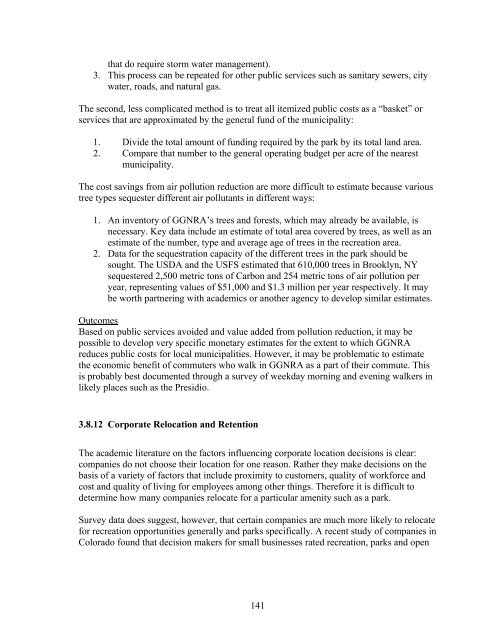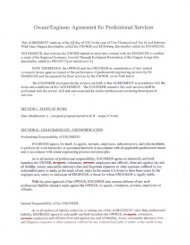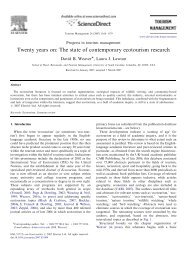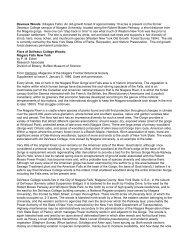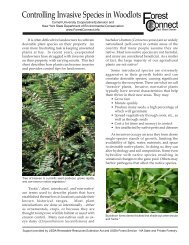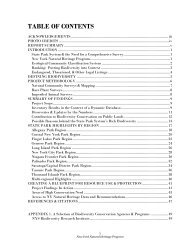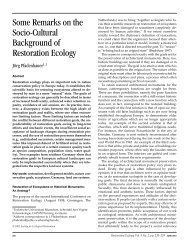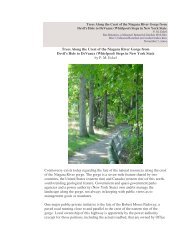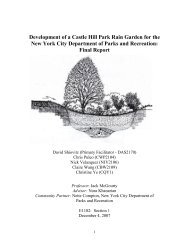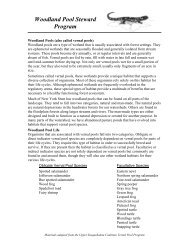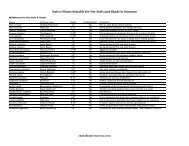Economic Impacts of Parks, Rivers, Trails and Greenways
Economic Impacts of Parks, Rivers, Trails and Greenways
Economic Impacts of Parks, Rivers, Trails and Greenways
You also want an ePaper? Increase the reach of your titles
YUMPU automatically turns print PDFs into web optimized ePapers that Google loves.
that do require storm water management).3. This process can be repeated for other public services such as sanitary sewers, citywater, roads, <strong>and</strong> natural gas.The second, less complicated method is to treat all itemized public costs as a “basket” orservices that are approximated by the general fund <strong>of</strong> the municipality:1. Divide the total amount <strong>of</strong> funding required by the park by its total l<strong>and</strong> area.2. Compare that number to the general operating budget per acre <strong>of</strong> the nearestmunicipality.The cost savings from air pollution reduction are more difficult to estimate because varioustree types sequester different air pollutants in different ways:1. An inventory <strong>of</strong> GGNRA’s trees <strong>and</strong> forests, which may already be available, isnecessary. Key data include an estimate <strong>of</strong> total area covered by trees, as well as anestimate <strong>of</strong> the number, type <strong>and</strong> average age <strong>of</strong> trees in the recreation area.2. Data for the sequestration capacity <strong>of</strong> the different trees in the park should besought. The USDA <strong>and</strong> the USFS estimated that 610,000 trees in Brooklyn, NYsequestered 2,500 metric tons <strong>of</strong> Carbon <strong>and</strong> 254 metric tons <strong>of</strong> air pollution peryear, representing values <strong>of</strong> $51,000 <strong>and</strong> $1.3 million per year respectively. It maybe worth partnering with academics or another agency to develop similar estimates.OutcomesBased on public services avoided <strong>and</strong> value added from pollution reduction, it may bepossible to develop very specific monetary estimates for the extent to which GGNRAreduces public costs for local municipalities. However, it may be problematic to estimatethe economic benefit <strong>of</strong> commuters who walk in GGNRA as a part <strong>of</strong> their commute. Thisis probably best documented through a survey <strong>of</strong> weekday morning <strong>and</strong> evening walkers inlikely places such as the Presidio.3.8.12 Corporate Relocation <strong>and</strong> RetentionThe academic literature on the factors influencing corporate location decisions is clear:companies do not choose their location for one reason. Rather they make decisions on thebasis <strong>of</strong> a variety <strong>of</strong> factors that include proximity to customers, quality <strong>of</strong> workforce <strong>and</strong>cost <strong>and</strong> quality <strong>of</strong> living for employees among other things. Therefore it is difficult todetermine how many companies relocate for a particular amenity such as a park.Survey data does suggest, however, that certain companies are much more likely to relocatefor recreation opportunities generally <strong>and</strong> parks specifically. A recent study <strong>of</strong> companies inColorado found that decision makers for small businesses rated recreation, parks <strong>and</strong> open141


